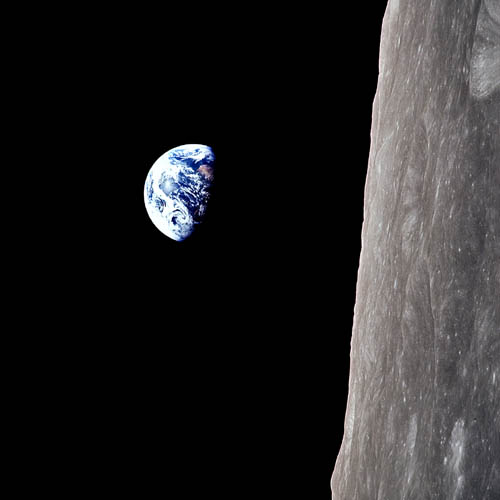
Name:
Earthrise - Apollo 8
Image Credit:
NASA
Release Date:
December 29, 1968
Original
NASA Caption:
AS08-14-2383 (24 Dec. 1968) --- The rising Earth is about five degrees
above the lunar horizon in this telephoto view taken from the Apollo 8
spacecraft near 110 degrees east longitude. The horizon, about 570 kilometers
(350 statute miles) from the spacecraft, is near the eastern limb of the
moon as viewed from Earth. Width of the view at the horizon is about 150
kilometers (95 statute miles). On Earth 240,000 statute miles away the
sunset terminator crosses Africa. The crew took the photo around 10:40
a.m. Houston time on the morning of Dec. 24, and that would make it 15:40
GMT on the same day. The South Pole is in the white area near the left
end of the terminator. North and South America are under the clouds
ABOUT THIS IMAGE:
This view of the rising Earth, in it's original orientation, greeted the Apollo 8 astronauts as they came from behind the Moon after the lunar orbit insertion burn. Earth is about five degrees above the horizon in the photo. The unnamed surface features in the foreground are near the eastern limb of the Moon as viewed from Earth. The lunar horizon is approximately 780 kilometers from the spacecraft. Width of the photographed area at the horizon is about 175 km (109 miles). On the Earth 386,000 km (240,000 miles) away, the sunset terminator bisects Africa.
From
Wikipedia:
Earthrise is the name given to NASA image AS8-14-2383, taken by astronaut
William Anders during the Apollo 8 mission, the first manned voyage to
orbit the Moon. In Life's 100 Photographs that Changed the World, (the
late) wilderness photographer Galen Rowell called it "the most influential
environmental photograph ever taken.
Initially, before Anders found a suitable 70mm color film, mission commander Frank Borman took a black and white photo of the scene, with the Earth's terminator touching the horizon. The land mass position and cloud patterns in this image are the same as those of the color Earthrise photo.
The photograph was taken from lunar orbit on December 24, 1968 with a Hasselblad camera. An audio recording of the event is available with transcription which allows the event to be followed closely – excerpt:
Borman:
Oh my God! Look at that picture over there! Here's the Earth coming up.
Wow, is that pretty.
Anders: Hey, don't take that, it's not scheduled.
Borman: (laughing) You got a color film, Jim?
Anders: Hand me that roll of color quick, will you...
The TV miniseries From the Earth to the Moon, drawing upon the book A Man on the Moon by Andrew Chaikin, has Borman uttering the "it's not scheduled" remark (in part four, "1968", at 41' 57"). However, the PBS attribution to Anders is clear from the sound recordings. In fact, had Borman as mission commander said such a thing, the color photograph would never have been made.
There were many images taken at that point. The mission audio tape establishes several photographs were taken, on Borman's orders, with the enthusiastic concurrence of Lovell and Anders. Anders took the first color shot, then Lovell who notes the setting (1/250th of a second at f/11), followed by Anders with another two at varying exposures.
The picture attested by Frank Borman is in nearly the same place with respect to the horizon as the one usually credited to Anders, but was probably taken on a different orbit — the cloud patterns are significantly different to the color Earthrise.
A nearly full-page black and white reproduction of Borman's image may be viewed on page 164 of his 1988 autobiography, captioned: "One of the most famous pictures in photographic history — taken after I grabbed the camera away from Bill Anders". Borman was the mission commander and notes (pg 212) that this is the image "the Postal Service used on a stamp, and few photographs have been more frequently reproduced" — but see above.
The stamp issue reproduces the cloud, color and crater patterns of the Anders picture. Anders is described (pg. 193) by Borman as holding "a Masters degree in nuclear engineering"; Anders was thus tasked as "the scientific crew member ... also performing the photography duties that would be so important to the Apollo crew who actually landed on the moon".